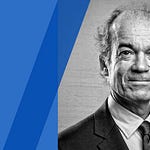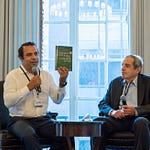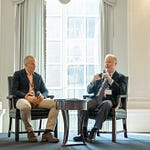We continue this series with a program on Sam Zell, who built a $5+ billion fortune from scratch by rigorously applying a simple set of investing and operating principles. Join John Mihaljevic, Chairman of MOI Global, on this two-hour journey to see how each of us can apply Zell’s principles.
In early 2007, Zell pulled off a stunning real estate deal, selling his Equity Office Properties trust to Blackstone for $39 billion near the peak of the market. Within a year, property values collapsed. Just months after that triumph, Zell plunged into another deal: a debt-fueled buyout of the Tribune Company, a contrarian bet on the dying newspaper business he later dubbed “the deal from hell”. Tribune went bankrupt a year later, costing him $315 million. These two 2007 deals — one brilliantly timed success and one notorious failure — encapsulate Zell’s career.
Nicknamed “the Grave Dancer” for buying distressed assets and profiting from others’ missteps, Zell defied conventional wisdom to seize opportunity in chaos. When others zigged, he zagged. As he put it, “If everyone’s going left, look right.” Despite his maverick persona, he was an analytical, disciplined strategist. Zell was no reckless gambler, but a calculated risk-taker who always asked: what’s the worst-case scenario, and can I survive it?
Zell summed up his approach bluntly: “If you’ve got a low downside and a big upside, you go for it. If you’ve got a big downside and a small upside, you run away.” By that rule, he walked away from many deals that didn’t offer a sufficient margin of safety, and structured those he did pursue to limit downside. He would put his neck on the line when conditions favored him, then swiftly dial back risk when the tide turned. In his view, bold bets meant nothing if you couldn’t survive the bad times.
A key to Zell’s success was an uncanny sense of cycles. He excelled at exploiting the capital cycle, diving in when capital fled and cashing out when exuberance returned. By the mid-2000s he was a dominant figure in U.S. commercial real estate, and in 2007 he sold Equity Office near the peak.
His biggest flop, the Tribune deal, underscored the perils of excessive leverage and venturing outside one’s core competence, proof that even a legendary contrarian can misjudge an industry. Yet he structured it like a call option, risking only a small sliver of his own capital for a chance at a big payoff. In this ill-fated venture, he stuck to his rule of limiting downside — a failure that hurt his pride but not his survival.
Zell’s career is a study in balancing audacity with methodical risk management. He showed that an investor can dance on others’ graves without digging their own. This program dives into Zell’s playbook, examining how he melded daring opportunism with rigorous downside protection. The lessons in timing, capital cycles, and independent thinking offer valuable insights for value investors.
Overview:
Contrarian Beginnings and Early Deals
Building a Real Estate Empire and Cycle Timing
Equity Office Sale — Timing the Market Peak
Tribune Company Buyout: The “Deal from Hell”
Zell’s Risk Philosophy and Lasting Lessons
Applying Zell’s Principles to Become Better Investors
Enjoy the program!
Condensed Transcript
We recommend listening to the audio program for greater depth and nuance.
So today we’re going to see what we can learn from Sam Zell, known as a real estate‑focused value investor and bargain hunter—somebody who built a fortune by looking for deals that others were either too lazy to seek out or simply could not find because they didn’t have the right toolkit. I’m really excited about what we’re going to learn today, because I think the lessons are applicable not just to real estate but also to public markets in general.
It’s early 2007 and Sam Zell has just pulled off one of the most stunning deals in real estate history. He sells Equity Office Properties, the largest office REIT in the U.S., to Blackstone for $39 billion in the largest leveraged buyout ever in commercial real estate. Zell cashes out near the very peak of the market, personally pocketing more than $1.1 billion. Within a year, the financial crisis hits and property values plummet. It seems Sam Zell had executed a masterstroke of timing, cementing his legend as a man with an uncanny sense of when to buy and, crucially, also when to sell.
Yet in that very same year, 2007, Sam Zell made another headline‑grabbing deal—one he would later dub the “deal from hell.” He took the helm of the fading Tribune Company in a debt‑fueled buyout, becoming owner of the Chicago Tribune and Los Angeles Times, just as the newspaper business imploded. Tribune went bankrupt a year later, costing Zell a personal $315 million loss. This whiplash-inducing pair of 2007 deals—one brilliantly timed success and the other a notorious failure—encapsulates the high-stakes career of Sam Zell. He was a daring contrarian known as “The Grave Dancer” for his habit of picking up distressed assets and essentially dancing on the skeletons of other people’s mistakes. He reveled in defying conventional wisdom and finding opportunity amid chaos.
So now we’re going to really explore Sam Zell’s investing life—from his upbringing and path to becoming a self-made billionaire, to his track record of deals (the triumphs as well as the missteps), and the investing philosophy and principles that guided him. We’re going to hear from Sam Zell himself and learn from his own words, not just from other people’s observations. He once said, “If everyone’s going left, look right.” And that is a good way to sum up much of his contrarian streak.
What’s interesting to note about the Tribune Company, before we move on, is I recall Warren Buffett commenting on that bargain-basement purchase Sam Zell made—because Zell got the equity basically for free or close to free. Buffett’s observation was that now Zell still had the Tribune Company to run. I think Buffett was already seeing, from his own experience in the newspaper industry, that there was a lot of trouble ahead, and it wasn’t just cyclical.
Let’s look at Sam Zell’s making as an investor. His story starts with the gritty determination of an immigrant family and a kid who simply was different. He was born in Chicago in 1941 to Polish-Jewish parents who had narrowly escaped the Holocaust, fleeing Europe just months before Sam’s birth. Growing up, Sam was keenly aware that his family’s experiences set them apart. “Growing up as the kid of an immigrant, things were a lot different in my house than anybody else’s. All those differences produced a different person than the average,” Sam reflected years later. And Sam said, “I for sure claim to be different.” This sense of being an outsider would later feed his comfort with contrarian thinking and going against the crowd. It was embedded in his identity—he never felt the need to belong to the group or be “average,” so to speak.
His father was a successful businessman—opinionated, demanding, entrepreneurial. From him, young Sam absorbed early lessons in hustle and risk-taking. In fact, Sam’s entrepreneurial streak showed up almost as soon as he could ride a bike. Family lore (and Sam himself) recount that as a preteen in the 1950s, he discovered a Playboy magazine and realized his friends at school would eagerly pay for it. The enterprising 12-year-old managed to acquire stacks of Playboy and sold them at a hefty markup to his middle-school buddies. He says, “I recognized a need common in all 13-year-old boys, saw a restriction on supply, and I took advantage of it.” He recounted decades later, noting that “50-odd years later, I’m still doing the same thing.” Quite the story there. Basically, it’s an extreme example of him spotting unmet demand, exploiting supply-demand imbalances and seizing the opportunity to profit, even if it meant bending a few rules. Certainly a lot of kids would have shied away from hawking copies of Playboy to their teenage friends.
As a teenager Sam was already outspoken and unafraid to be bold. His high school yearbook quote was, “I am not arguing with you; I am telling you.” That line hinted at the force of will and confidence that would come to define him.
In 1959, he left home for the University of Michigan, and there his business exploits truly took off. As an undergraduate, he talked his way into managing a 15-unit apartment building near campus in exchange for free room and board. Soon he was managing other student apartment properties and brought in his fraternity brother and future lifelong business partner, Robert Lurie. Zell and Lurie began not just managing apartments, but buying them with creative financing. By the time Sam Zell graduated law school in 1966, the duo was overseeing a mini real estate empire of more than 4,000 apartments (with 100-plus units owned outright), all while Zell was still a student.
That’s really astonishing. You have a twenty-something law student running thousands of rental units on the side—it speaks to his boundless energy and appetite for deal-making, even in his early twenties. And this is something that really cannot be taught. You’re either going to have that mentality or not, unfortunately for a lot of us.
I certainly don’t claim I did anything close to that while in college, or that I could have done it given the mindset I had at the time (which was very much academic-focused). So it’s basically an “either you have it or you don’t” kind of thing. But I don’t want to settle on that conclusion, because we can grow and improve over time—including our mindset, our risk-taking, and all aspects of our lives. I want to explore Sam Zell’s journey and see what we can learn and apply to our own business and investing journeys.
After earning his J.D., Zell lasted only a few days as a practicing lawyer. The button-down world of legal work was far too staid for a deal junkie of his caliber. “I practiced law for four days before throwing all my weight into business,” Zell quipped. So he immediately went back to what he loved doing, which was real estate investing. He sold his student apartment management company to Bob Lurie (who stayed on to run it), and Zell moved to Chicago to hunt for bigger opportunities. A few years later he reunited with Lurie and they formally partnered. The timing was perfect. The late 1960s and early ’70s brought turmoil to real estate markets, and Sam Zell, barely 30 years old, was poised to capitalize on that. His initial claim to fame came from recognizing the huge real estate crash of the 1970s as the chance of a lifetime. (Clearly that was a cyclical downturn, although maybe someone at the time claimed it was more permanent—as people often do when markets are at lows.)
Zell became a “grave dancer,” scooping up distressed properties on the cheap. He observed fundamental facts like high inflation, a lack of new construction, and population growth, and drew non-obvious conclusions. In one instance, he snapped up a portfolio of railcars through a company called Itel in the early 1980s. Itel looked like a disaster, a struggling business with dismal 32% railcar utilization. To Zell, it looked like a platform. He immediately put on his puzzle-solving hat. The data was available to all, but Zell was the one who “put the pieces together.” He saw that almost no new boxcars had been built for years, and that this pattern of under-investment could create a supply squeeze. It was out of favor—people looked at the industry and saw poor performance—but Zell saw an opportunity in the anomalies. “It isn’t like there are six rules of investing. For me, there is no formula,” he said of his approach. The common thread was finding value through underappreciated assets, whether those assets were hard assets like railcars or financial quirks like tax credits. Zell was essentially asset-agnostic; as he put it, “What I really am is an entrepreneur. I focus less on specific industries and more on seeing opportunity in anomalies.”
Time and again, Zell delighted in going against the trend. Contrarian opportunism was perhaps his defining trait. Conventional wisdom meant nothing to him but a reference point. He viewed the crowd as dangerous. He once wrote that conventional wisdom “can be a horribly debilitating concept.” His famous encapsulation of this philosophy was, “If everyone is going left, look right.” In other words, when the whole market is screaming one thing, that’s exactly when you should question it. His career was a testament to this. He bought when others were selling (in the 1970s and 1990s busts), and he sold when others were buying (such as at the 2007 peak).
He attributed much of his success to simply not being swept up in popular sentiment. “I always seem to have a lot of self-confidence, so I didn’t pay attention to conventional wisdom,” Zell said. Instead, he prided himself on independent judgment. As he explained, “Once I have formed my opinion, I have to trust my perspective enough to act on it. I stay with my decision even when everyone is telling me I’m wrong, which happens a lot.” That takes nerve. (It reminds me of Seth Klarman’s remark that value investing is like an inoculation—you either have it or you don’t. The same applies to being truly contrarian; it goes deep into one’s self-identity and personality. Many people simply cannot help but be part of the crowd, however much they deny it. They end up justifying whatever the crowd believes at the moment and rationalizing it. This herd mentality causes markets to overshoot on the upside as well as the downside—and that is where the ultimate opportunity lies.)
Another pillar of Zell’s investment philosophy was focus on the downside. Risk management was a core discipline for him. Time and again, he emphasized understanding and controlling the downside as the key to successful investing. Zell was almost obsessive about asking, “What are all the variables, and which ones will make or break us? What’s the worst-case scenario, and can I survive it? What actions would we take? Can I bear the cost? Can I survive it?” Only if he was comfortable with the answers would he proceed.
A classic Sam Zell case study illustrating this is his early-1990s investment in the retailer Carter Hawley Hale (CHH). Before buying that bankrupt retailer’s debt in 1991, Zell sent an associate, David Contis, to evaluate every single store and its inventory—not to see growth potential, but to price a fire-sale liquidation. “Go look at every store—who we would want, who we would sell it to, and what we would get for it in case the deal goes south,” Zell instructed. Contis did so and reported back that even in a worst-case liquidation, they’d recover 80% of their investment. That meant the downside risk was a 20% loss. Sure enough, they did the deal (investing $220 million for control of CHH) and the retailer never really turned around. Three years later, Zell sold the floundering chain, basically breaking even at roughly 80% of his purchase price. So the downside did come to pass—they lost about $50 million, which was exactly the downside they’d identified going in. And to Zell, that outcome was actually a kind of success: their risk analysis was spot on. They went into the deal knowing they could lose $50 million, and they were willing to risk it for the potential upside.
This story shows how Zell engineered his luck by limiting the potential loss on a deal. By ensuring the worst case was tolerable, he could still swing for the fences on the upside. He summed up his philosophy quite simply: “If you’ve got a low downside and a big upside, you go for it. If you’ve got a big downside and a small upside, you run away.” (This is a bit like Mohnish Pabrai’s “Dhandho” philosophy.) Zell really lived this. He walked away from countless flashy deals that had too much downside risk or complexity. “I always focus on how much exposure I am taking—what’s the outcome if everything goes wrong? Can I survive it?” As he explained, “I knew that I could always survive the good days. But the critical element is to be able to survive when the market isn’t doing well or the investment isn’t performing.” It’s reminiscent of Buffett’s adage: Don’t risk what you can’t afford to lose.
It’s also worth noting Zell’s personal courage when it came to risk. Now, some may say that didn’t pan out with the Tribune Company—after all, he did lose his entire equity there. But Zell understood that deal going in: he knew he was essentially buying a call option. He put up $300 million to acquire something with an enterprise value of over $8 billion at the time, which basically is a call option. To Zell, the Tribune bet was one he could survive if it went wrong. It was just a piece of his portfolio. It also kind of violated Zell’s own rule: “Investors stumble when they shift to doing something outside their core competencies.” And Tribune was certainly that. (Zell had no background in media and was perhaps too optimistic about newspapers.)
In fairness, some have noted that Zell’s actions during Tribune’s brief period under his ownership were logical—he sold the Chicago Cubs and some real estate to raise cash, cut costs, all the things any private equity owner would do. It just wasn’t enough against tidal forces. The Tribune saga doesn’t erase Zell’s legacy, but it does humanize him a bit, showing that even a legendary investor can misread an industry trend. It highlights the danger of too much leverage as well—Zell used plenty of leverage over the years, but usually asset-backed and moderate. Tribune was a full corporate LBO in a declining sector, basically a bridge too far.
Zell himself joked about his Tribune misstep. He took it on the chin; he said, “If I’m stupid enough to do it a second time, then you can shoot me,” he joked. The episode reinforced his belief that luck—good or bad—plays a role. People often ask how much of success is skill versus luck, and his take was: I don’t know the exact mix, but at least in my business, luck is certainly enhanced by a keen sense of awareness. And by “awareness,” he means preparation and observation. In Tribune’s case, perhaps Zell’s usually keen awareness didn’t fully anticipate how the internet (especially online classifieds and advertising) would gut the newspaper business.
To me, Tribune was a case of someone who knew the assets (particularly the Chicago Tribune) extremely well over a lifetime, and essentially thought they were such institutions that they wouldn’t decline so quickly. He misjudged what was coming with the internet. What I would also say here—and I’ve said it before—is that Tribune was essentially structured as a call option, and that call option expired worthless. He lost 100%. But it was a small equity investment compared to the enterprise value; had the business stabilized, he had multi-bagger upside on his equity. As with any call option, if it pays off, it’s huge, and if not, you lose your premium. Zell lost his premium, but it was a bet he could afford. (One last observation on Tribune: some have pointed to the journalists and editorial staff rebelling against Zell’s brash style as a cause of failure. I would downplay that—those staffs had already lost a ton of their power with the decline of newspapers, so Zell could have replaced them easily. That wasn’t really why the investment failed.)
In summary, we’ve now traveled together through roughly six decades of Sam Zell’s journey—from the boy selling magazines for a profit (remember the Playboy magazines he sold to classmates), to the young entrepreneur managing thousands of apartments as a student, to the “Grave Dancer” scooping up distressed skyscrapers in the ’70s (arbitraging inflation by borrowing at rates below inflation), to the corporate trader of tax-credit-rich companies, to the billionaire investor orchestrating mega-deals like the 2007 sale to Blackstone—demonstrating once again the value of zigging when others are zagging.
It’s well known, but hard for most people to implement: it takes courage to be contrarian. I think that’s something that can never be emphasized enough. Another key takeaway is how much Zell valued liquidity and flexibility. He really saw the value in being able to move quickly and keep his options open. He often kept ample cash or undrawn credit lines so he could strike when markets panicked. Liquidity gave him flexibility, which he valued immensely. Closely tied to liquidity was scale and optionality. Zell emphasized scale; he said that without scale, you don’t have liquidity, you have no optionality—in essence, you’re stuck. This is why he built companies to be number one or number two in their sectors (largest landlord, largest railcar lessor, etc.). Scale not only brought operating efficiency, but also made his holdings more financeable and salable. By achieving scale, he ensured he could attract capital or buyers at any time, further reducing risk.
Another tenet was not fighting long-term demand trends. While a contrarian, Zell wasn’t foolish about secular demand. If he concluded an industry’s fundamentals were going irreversibly sour (like newspapers), no contrarian brilliance could save it. He believed you must have underlying demand tailwinds or else even a great operator will struggle. On the flip side, he had a knack for anticipating shifts in demand and getting in early. In the late 2000s, for example, he became a big investor in emerging-market infrastructure and real estate, because he saw population growth and urbanization trends that would drive demand.
Zell also built his empire on relationships and trust. He viewed partnerships as win-win, not zero-sum. If you made money as Sam’s partner once, you likely wanted to do it again. Many of Zell’s top executives stayed with him for decades. Stan Ross, a long-time colleague, once called Zell a visionary, and noted that Zell’s clarity in communication set the tone in his organizations. Zell had a whimsical side too—he titled the chapters of his autobiography with slogans like “No BS” to emphasize how he communicates. That sense of fun kept him and his team from getting complacent or too full of themselves. As Zell once said, basically, “Don’t think that your body odor is perfume.” In other words, don’t take yourself too seriously. In one of his “Eleventh Commandment” slogans, Zell put it as “Thou shall not take thyself too seriously.” Reflecting on his career, Zell remarked that when you’re a repeat player like him, “in any negotiation, leave a little for the other guy.” Even critics who didn’t like his Tribune handling conceded that Zell truly believed in what he was doing and was not acting in bad faith.
Ultimately, Zell was the ultimate opportunist. He went where the deals were. He didn’t operate under some grandiose macro theory of the world or stick to a rigid long-term plan. He simply pounced on opportunities as they arose, often in distressed or overlooked areas, always guided by his principles of contrarianism, downside protection, liquidity, and adaptability.
Sam Zell’s playbook isn’t one that can be easily replicated by just anyone—that unique mix of attitude, skill, and gut instinct was very much his own. But we can certainly learn from it. We can strive to be more courageous when others are fearful, vigilant about the downside even when others are greedy, and open to finding value in unexpected places. Zell’s career shows the rewards of zigging when others zag—and the importance of being prepared, liquid, and true to one’s judgment. It’s a legacy that offers lessons for any investor willing to be contrarian in search of opportunity.
Featured Events
Ideaweek 2026 (FULLY BOOKED), St. Moritz (Jan. 26-29, 2026)
Best Ideas Omaha 2026, Omaha, Nebraska (May 1, 2026)
The Zurich Project 2026, Zurich, Switzerland (Jun. 2-4, 2026)
Enjoying Latticework? Help us make it even more special.
Share Latticework (simply click the above button!)
Introduce us to a thoughtful speaker or podcast guest
Be considered for an interview or idea presentation
Volunteer to host a small group dinner in your city
Become a sponsor of Latticework / MOI Global
Volunteer by reaching out directly to John (john@moiglobal.com).











